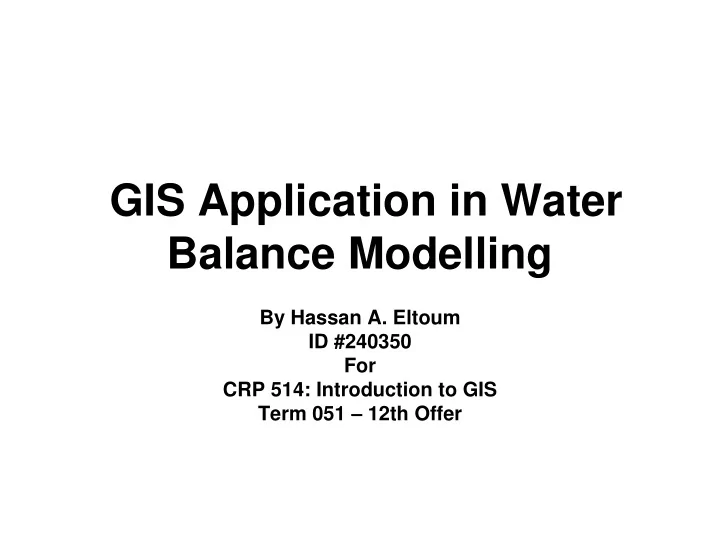

GIS Application in Water Balance Modelling By Hassan A. Eltoum ID #240350 For CRP 514: Introduction to GIS Term 051 – 12th Offer
Outlines • Introduction • Problem Statement • Objectives • Methods • Discussion • Summary
Introduction • Hydrological Assessment to represent hazard . • Hydrological Parameter Determination, • Hydrological Modelling within the GIS, provides feasible time • Linking the GIS and hydrological model.
Problem Statement • Big demand for the special analysis • Demand reflect on the need of water balance modeling • better look to analysis any problem in water resources
Objectives 1- Elaborate on general idea for modeling water balance and, 2- have a look to developing tools for predicting hydrographs and pollution
Methods • (1) DEM processing, • (2) selecting a set of flow gages spanning the appropriate period of record, • (3) Compiling Watershed Attributes • (4) determining the average annual precipitation in each watershed, • (5) determining the net measured inflow to each watershed, • (6) compiling a set of watershed attributes including percent urbanization, reservoir evaporation, recharge, and spring flow, • (7) plotting runoff per unit area versus rainfall per unit area and deriving an "expected" runoff function, and • (8) creating grids of expected runoff, actual runoff, and evaporation.
(1) DEM processing
Steps of DEM
Delineating Watersheds from Selected Gages
Compiling Watershed Attributes
DISCUSSION • Atmospheric Water
Soil Water • Soil water is that water contained within the soil column • 1) soil moisture content to • 2) evaporation, • 3) precipitation, and • 4) outflow from the soil.
Groundwater • There are two kinds of groundwater flow: unconfined flow and confined flow • In constructing a groundwater balance model, there are two computations to be performed: • first, a water balance on each spatial unit • second, a flow computation between each pair of spatial units
Surface Water • Surface water is water in streams, lakes, wetlands and reservoirs Discharge = From Flow + (Polygon Flow / L) * D
SUMMARY • Many water balance methods - an atmospheric water balance, a soil-water balance, and a surface water balance - have been used in an attempt to gain an improved understanding of the stocks of water in different components of the hydrologic cycle and the fluxes between these components
CONCLUSIONS • Three water balance methods • an atmospheric water balance • a soil-water balance • a surface water balance • an attempt to gain an improved understanding of the stocks of water in different components of the hydrologic cycle and the fluxes between these components.
RECOMMENDATIONS • As spatial data sets from remote sensing • A large amount of data for the state of region will be useful to others in the future.
QUESTIONS • ?
Recommend
More recommend